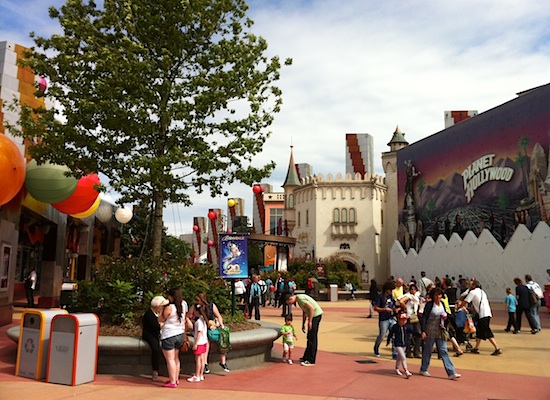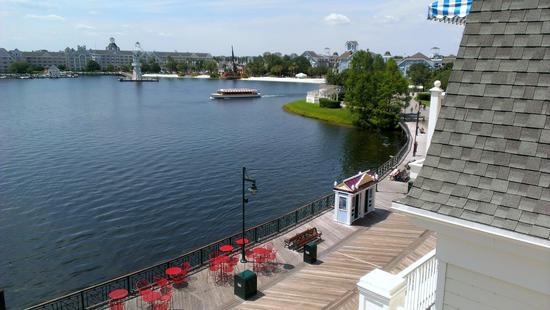Why? Let's consider the competition. The world's other major multi-park theme park resorts — Disneyland, Disneyland Paris, Tokyo Disney, and Universal Orlando — all occupy much less space than Walt Disney World. Those resorts' parks are located within walking distance of one another, with a central shopping and dining district also just steps away. They function like themed downtowns, faux urban cores with a high density of retail, accommodations and amusements. In Tokyo and Paris, these "downtowns" are linked to the rest of their metropolitan areas via mass-transit rail stations in the middle of the development. Disneyland Paris also includes car-dependent, exurban-style development on its periphery, but the central core around the two parks and its Disney Village functions the same as at these other theme park resorts.

But Walt Disney World — the first of these resorts, and as such, the prototype — is different. Built in the early 1970s on thousands of acres of undeveloped land in what was then the middle-of-nowhere Florida, the Walt Disney World Resort abandons Walt's initial vision of a modernist, transit-focused urban development in favor of a car-dependent exurban one. Even if you don't bring a car to the resort, you'll still find yourself on roads, riding in buses, if you want to get around and see all of what the resort has to offer. This is theme park suburbia. There's no urban core, no downtown, here.
Or is there?
No, what Disney calls "Downtown Disney" never was a functioning downtown. Located on the southeastern edge of the resort, far from its four theme parks, the former Disney Village never functioned as an urban core for Walt Disney World. In an effort to prevent visitors from taking advantage of free parking on its sea of asphalt surrounding these shops and restaurants, Disney no longer provides direct bus transportation from Downtown Disney to the theme parks. It's impossible for this "Downtown Disney" to function as a central core to the resort's theme parks if you literally can't get there from here on the resort's transportation system.
So forget about Downtown Disney as Disney World's downtown. That doesn't preclude another location from serving in that role. Where could that be?
It's helpful to consider first what the function of a resort "downtown" would be. You'd want a densely developed location, within walking distance of multiple parks, with shopping, dining and accommodations also located on site. Alternate transportation would be available for those who don't wish to walk the farthest distances inside this core. Ideally, non-automotive transportation would be available to points beyond the central core, taking you elsewhere in the resort and perhaps even outside of it.
Actually, there is a location inside the Walt Disney World Resort that satisfies most of these requirements. And, as you might expect, it's nowhere near what Disney calls Downtown Disney. So where is it?
It's Disney's Epcot Resorts area.

Located between Epcot and Disney's Hollywood Studios, you can reach either of those parks on a footpath linking the five hotels in this area: Disney's Yacht Club Resort, Disney's Beach Club Resort, Disney's Boardwalk Resort and the Walt Disney World Dolphin and Swan. Don't want to walk? A "Friendship" boat will be along in just a few minutes to take you down the waterway that also connects these parks and hotels. You'll find abundant dining in the area, even if the retail's a bit light for a downtown. Want to get to other parks? Yes, there are buses, but if you walk through Epcot, you'll find a monorail station awaiting you on the other side, ready to whisk you over to the Magic Kingdom and its collection of hotel resorts.
If you're willing to ignore Animal Kingdom, the water parks and the soon-to-be Disney Springs, one easily could enjoy a road-free vacation staying at the Epcot Resorts Area, walking, boating and taking the monorail around these hotels, restaurants and theme parks. It could be just like a vacation at one of the other multi-park theme park resorts around the world. You'd be enjoying a "theme park downtown."
There is guest demand for this level of convenience. Perhaps it's not a coincidence that one of the hotels located in the center of the Epcot Resorts area, Disney's Yacht Club Resort, was the highest-rated Walt Disney World hotel in our most recent Theme Park Insider Awards. Some people like to ditch their cars on vacation, yet remain in the midst of plentiful entertainment options.
Of course, Disney's poured many millions of dollars into developments not linked to this downtown core, and millions of Disney visitors want to experience those parts of the Walt Disney World Resort, too. So, for the time being, at least, the Walt Disney World Resort will continue to be a road-dependent resort for the vast majority of its visitors. But I think there's great value in recognizing the Epcot Resorts Area as a proto-urban core for the resort.
We might have surpassed the point of peak car dependency in America. Younger Americans aren't getting drivers' licenses at the same rate their older siblings and parents once did. The specter of Peak Oil looms. And, anyway, Disney clearly would prefer that its visitors not rent cars while in Orlando, which they might use to visit other, competing attractions in the area. (That's why it offers that Disney's Magical Express service to and from the Orlando Airport.)
But, let's face it, people don't like buses. If Disney wishes to create alternates to road transportation at the Walt Disney World Resort, it can most cost-efficiently route high-capacity non-road transit systems by developing the resort using the classic "hub and spoke" design that Walt developed for Disneyland and for his vision of Epcot — a design that was very much inspired by scholars of urban design. But Disney won't need to spend billions of dollars to create that hub from scratch if it recognizes where its urban core already might be evolving.
Perhaps then, the Epcot Resorts area can become a fully-functioning Downtown Disney for everyone at the Walt Disney World Resort.
Tweet
You can walk from their resorts to the parks and all the shopping. (Well, except the new one they are building. I don't know if that will be in walking distance.)
I would love to see an improvement to the WDW transportation system. I know a monorail track is really expensive to build, but it always made sense to me to run a monorail to Animal Kingdom because they run on electricity and are very quiet, so as to not pollute with CO2 or noise anywhere near the animals.
Looking at the resort's layout and map, I don't really see any other areas to improve the transportation system. A monorail could be run to Hollywood Studios from the Ticket & Transportation Center, but in relation to EPCOT and Magic Kingdom, Hollywood Studios is tiny, and not worth the trouble or cost. At least not until or unless they really expand the park with Star Wars, CarsLand, a larger Pixar Place, etc. If Hollywood Studios were an actual destination park that took more than half of a day to completely explore, that could be an option to consider. I just don't see it.
Unfortunately I think what we have is what we're always going to have. It was poorly planned from the get go, with the thinking seemingly that they have all this land, so just build whatever, wherever with no forward thinking in mind. And it's such a shame. But there is still hope, and there are options available, should they choose to do it.
That being said, Robert's suggestion of the Epcot Resort Area as "downtown" makes total sense.
Tracy, if you're talking about the Cabana Bay Beach Resort it'll be connected to Citywalk via a pedestrian bridge being built over Hollywood Way, then the sidewalk along Hollywood Way down into the access area next to Margueritaville.
A good option if Disney wants to invest is a new downtown west of the World Drive/Epcot Drive intersection immediately north of Coronado. Would be interesting to turn into a hub with a shopping/entertainment area, large upscale hotel and a large convention center. Re-route the MK-Epcot line to hub here. It's also a short hop for a monorail to the Animal Kingdom. Use light rail to go to DHS with a stop at Epcot Resorts.
You can put Coronado, Blizzard Beach, and AK lodge on the AK run. Epcot Resorts sits on the DHS run. While water transport is fun, it is slow. Put a feeder line to MK from the Wilderness lodge, campground, Port Orleans, Key West, and Epcot. Put a separate feeder from AK, All Star, Wild Word of Sports, Art of Animation, Pop Century, and Caribbean Beach and DHS. The feeder lines also provide redundancy for every route.
JP
The name Downtown Disney suggests it is a public oriented shopping center for Disney fans, while the Boardwalk is designed for resort guests near Epcot. I never felt the Boardwalk is comparable in any sense to Downtown Disney. They each have a different retail/shopping/entertainment mix.
Downtown Disney's main problem is oversaturation. There is only so much you can milk from the tourist market. It needs to attract more locals to visit. It probably failed with local residents unlike other locations especially in Anaheim where I visit quite frequently as a local since I only live 15 minutes away. The WDW's Downtown Disney is much closer to the competition like Universal's Citywalk, which I felt was a much better product.
DD's other problems include the closure of its nightime entertainment. I am sure this will be remedied in the future.
While cars have lost their social status enabling function, buses did not lose their stigma. This is why "nobody likes buses". Buses are alright and quite liked in Europe where the stigma does not exis.
Not that this is an excuse to make people drive substancial distances with buses when one could have just built things closer together. In addition, one would think a theme park dreamworld is the last place to rely on buses instead of cool less economical methods.
Again: True story.
This article has been archived and is no longer accepting comments.